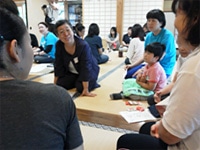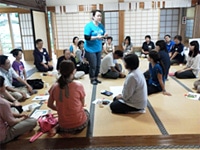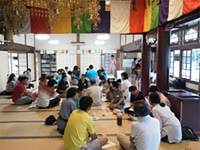



[OTSUCHI, Iwate, Japan, 1 July 2011]
Otsuchi Town, Iwate Prefecture, lost many of its municipal government employees in the March 11 tsunami, including the town’s mayor. On 30 June, a town hall meeting was held with the support of the Japan Committee for UNICEF to consider reconstruction assistance for children from various perspectives and positions.
The meeting was scheduled for 3:00 p.m. on a weekday afternoon. Nevertheless, teachers and parents from the town’s schools, preschools and kindergartens gathered for the meeting at the main hall of Kichijo Temple located in the Kirikiri District of Otsuchi. The meeting was also attended by local residents from the community that watch over the safety of commuting children on a daily basis, making for a total of 34 participants. At the meeting, participants exchanged views from their respective positions about the problems that children face in Otsuchi Town and their suggestions for the future role of assistance activities.
 |
| Professor Morita facilitating the opinion exchange. |
One female teacher from Otsuchi High School told us that, “The children were not talking about the disaster, so the teachers didn’t bring it up.” She continued, “Amidst those circumstances, some of the children in class began to say things like ‘We really have to restore the shopping arcade’ or ‘I wish they would fix that area this way.’ So, I had the students participate in discussions being carried out by the reconstruction council in order to offer views from citizens’ perspective. It was then that the students began to speak about the future of Otsuchi Town as well as their own futures; even children that usually don’t express their own opinions spoke out. There were some children that decided that they want to become clinical psychotherapists and return to Otsuchi to contribute to its reconstruction.”
Iwate Prefectural University Professor Katsuhiko Yamamoto participated in this town hall meeting along with Akemi Morita of Toyo University, who joined as an academic advisor. Speaking from their many years’ of experience in child-rearing assistance and child-friendly urban development, the professors told participants of an existing trend where children that feel loved by their community tend to want to return later in life. “Why will the children of Otsuchi that suffered in the disaster want to return to the town in the future once they are adults? We may need to ask them what makes them feel loved,” comments Professor Morita.
 |
| The Japan Committee for UNICEF (JCU) advocates child-friendly reconstruction. On this occasion, JCU assisted the holding of the town hall meeting, which was planned under the initiative of the community. Here, Iwate Field Manager Ms. Kondo (center) greets the participants. |
The participants are in contact with different age groups of children, but they all stated the same opinion: “The children look fine at a first glance, but they are always facing something.” Meanwhile, some participants voiced similar opinions about adults in this situation. One female participant commented that, “This is a small community, so everyone used to know about everyone else’s situation. But now, after the disaster, no one really knows what kind of troubles others face, and nobody wants to ask too many personal questions.”
However, a unifying source of energy for people in such a situation is children. Children have made the most of their situation by using stationery in creative ways to play in classrooms, since their normal play areas have been washed away. One boy who has been working to pull together new members to join a youth baseball team that recently restarted practice told us, “We now support and get support from a team that used to be our rival.” Despite the hardships of their situation, children are using this opportunity to begin giving a renewed sense of power to the community.
 |
| Despite the meeting’s time on a weekday afternoon, 34 men and women representing a broad range of age groups traveled to the main hall of Kichijo Temple, the meeting’s venue. |
Many of the areas damaged in the disaster had been calling attention to the serious problems of population aging and birth rate decline since before the disaster. Mamoru Higashiume, who gathered participants for this event and is the Chair of the Otsuchi Town PTA Federation, asserted the importance of reflecting the views of children in reconstruction plans, commenting, “It is vital that we think about the children when considering the reconstruction of Otsuchi Town. I hope to utilize the help of a wide range of individuals in making Otsuchi Town an even better place than it was before. It is therefore necessary to make Otsuchi into a place that the children want to live in, or return to someday.”
Professor Morita spoke about taking advantage of the strengths of children in order to rejuvenate adults. Professor Morita said that social welfare in Japan started after the Great Kanto Earthquake. This was first manifested in the form of poverty reduction (settlement) activities. He said that children served as an axis for such activities, and when the children changed, the adults followed, engendering a total change across society.
Professor Morita commented, “I am moved that we were able to get this many people together on only a week’s notice. Even when we try to do the same thing in Kanto, where residents outnumber those here by several dozen times, we only get half the turnout. I am motivated by the drive of the people of Otsuchi Town. If you begin listing things you don’t have, we could be here forever. But everyone here today has something, and that something is the children that support us. It is important that you all work to crystallize your thoughts and ideas into something concrete. You must listen to the views of children and reflect those in policy. Please continue to press the Government.”
All photo credits: © Japan Committee for UNICEF
| Receiving Prefecture |
Type of Emergency Supplies |
Arrival Date |
Quantity | Donating Company |
Comments |
|---|---|---|---|---|---|
| Miyagi | Water | 19 Mar. | 12,288 bottles |
VanaH Co., Ltd. | Two-liter plastic bottles |
| Fukushima | Water | 22 Mar. | 12,672 bottles |
VanaH Co., Ltd. | Two-liter plastic bottles |
| Miyagi | Underwear for boys and girls | 22 Mar. | 200,000 | ||
| Iwate | Underwear for boys and girls | 23 Mar. | 30,000 | ||
| Fukushima | Water | 23 Mar. | 4,680 bottles |
KIRIN MC DANONE WATERS Co., Ltd. | Two-liter plastic bottles |
| Miyagi | Children’s shoes | 23 Mar. | 10,000 pairs |
||
| Miyagi | Children’s diapers | 24 Mar. | 80 packs | P&G Japan | |
| Iwate | Children’s underwear | 24 Mar. | 9,700 | ||
| Fukushima | Water | 24 Mar. | 12,288 bottles |
VanaH Co., Ltd. | Two-liter plastic bottles |
| Iwate | Shoes | 26 Mar. | 1,404 pairs | Achilles Corporation | |
| Iwate | Underwear for boys and girls | 27 Mar. | 28,266 | ||
| Iwate | Boots | 27 Mar. | 7,462 pairs | ||
| Iwate | Wipes | 28 Mar. | 1,200 | P&G Japan | For babies |
| Miyagi | Recreation kits Early Childhood Development kits |
2 Apr. | 50 of each | Procured from the UNICEF Supply Division | |
| Iwate | Recreation kits Early Childhood Development kits |
2 Apr. | 50 of each | Procured from the UNICEF Supply Division | |
| Miyagi | Book bags | 6 Apr. | 70 | Nihon New Bag Chain | |
| Iwate | Book bags | 6-7 Apr. | 340 | Seiban | |
| Miyagi | Schoolbags | 8 Apr. | 18,000 | Procured from the UNICEF Supply Division | |
| Iwate | Schoolbags | 8 Apr. | 18,000 | Procured from the UNICEF Supply Division | |
| Miyagi | Personal security buzzers (for crime prevention purposes) | 8 Apr. | 5,000 | ||
| Iwate | Personal security buzzers (for crime prevention purposes) | 8 Apr. | 5,000 | ||
| Miyagi | Minicar | 8 Apr. | 3 cars | ||
| Miyagi | Nutritional supplements | From early April | 4,000 bottles | ||
| Fukushima | Water | 11 Apr. | 1,536 bottles | VanaH Co., Ltd. | Two-liter plastic bottles |
| Miyagi | Replenishments for recreation kits | 12 Apr. | 60 sets | ||
| Miyagi | Miniature toy cars | 12 Apr. | Approx. 1,200 | TAKARA TOMY | |
| Sagamihara* | Water | 12 Apr. | 12,288 bottles | VanaH Co., Ltd. | Two-liter plastic bottles |
| Miyagi | Play mats | 13 Apr. | Two types; 80 of each type | IKEA | |
| Miyagi | Drawing sets | 13 Apr. | 60 sets | IKEA | |
| Iwate | Preschool-size chairs, tables and low tables | 14 Apr. | 75 chairs; 11 tables; 9 low tables | Donated to preschools, primary schools, junior high schools and high schools in the disaster area as well as their new locations | |
| Miyagi | Mopeds | 15 Apr. | 5 | ||
| Iwate | Notebooks and stationery sets for primary and junior high school students | 15. Apr. | 16,700 sets | ||
| Miyagi | 183 computers; 57 copiers and fax machines; 61 printers | 18-21 Apr. | Distributed to preschools, primary schools, junior high schools and high schools in the disaster area as well as their new locations | ||
| Fukushima | Movable blackboards | 21 Apr. | 10 | ||
| Fukushima | Temporary toilets | 22 Apr. | 20 | ||
| Iwate | Geiger counters | 28 Apr. | 14 | For schools in Soma City | |
| Iwate | Dressing room/ breastfeeding partition system | 28 Apr. | 21 sets | ||
| Saitama* | Milk | From late April | Shelter in Futabamachi, Kazo City | ||
| Saitama* | Yogurt | From early May | Danone Japan | Shelter in Futabamachi, Kazo City | |
| Iwate | Color pencils (120 sets) and paint (240 sets) | 13 May | |||
| Iwate | Student lamps | 14 May | 15 | ||
| Iwate | Stationery sets | 16 May | 840 sets | ||
| Fukushima | Lockers | 16 May | 22 sets | For the Board of Education of Minamisoma City | |
| Fukushima | Computers | 16 May | 1 | Ishikawa Town Board of Education | |
| Miyagi | 2 copiers; 2 computers; 2 printers | May | For Higashi-Matsushima Day-Care Center and Watari Day-Care Center | ||
| Iwate | Water receiving tank, water purifier tank, water supply tank | May construction | May construction | ||
| Miyagi | Solar-powered vaccine refrigerator | 18 May | |||
| Fukushima | Fans | 30 May | 112 | Minamisoma City Board of Education | |
| Fukushima | Masks | 30 May | 100,000 | Minamisoma City Board of Education | |
| Iwate | 1 copy machine | 2 June | |||
| Saitama* | Shoes | 15 June | 460 pairs | Converse Footwear Co., Ltd. |
-Number of UNICEF Children’s Mini Libraries distributed: Approximately 150,000 books to over 900 locations (as of 20 June 2011).
-Number of children that have participated in the UNICEF “Let’s Play! The Outdoors Playtime Project” in Fukushima Prefecture: Approximately 5,600 (as of 26 May)
*Areas receiving disaster victims.
*In certain cases some supplies may be taken from prefectural supply storage warehouses and distributed to shelters and disaster sites in other prefectures.
As of 9:00 a.m. on 17 June 2011 (compiled by the Information and Public Affairs Division).